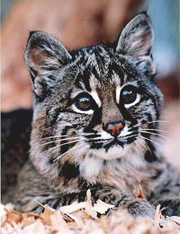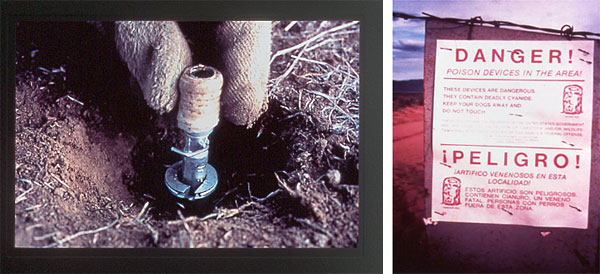Can wild cats and dogs be the guardians of vital sources of freshwater and other natural resources for humans?
Conservationists pressing for urgent protection of the world's last big cats and rare canids in the wild think this is one of many good reasons why the U.S. Congress should help protect such keystone species before they disappear.
Eighty percent of all wild cat species and 25 percent of wild canids (the family of foxes, wolves and wild dogs) are in decline and in urgent need of assistance, a coalition of wildlife conservation organizations said in a report released today.

The report, The Fading Call of the Wild, was authored by Panthera, the International Fund for Animal Welfare, and the Wildlife Conservation Society, in cooperation with the Canid and Cat Specialist Groups of the International Union for the Conservation of Nature (IUCN).
The cats and canids at risk are "amazing iconic species," said Jeffrey Flocken, International Fund for Animal Welfare director for the District of Columbia, in a conference call with the media today. Of the 72 living species, 37 are facing decliining populations, 17 are stable, the population status is unknown for 13--and only 4 species are increasing, he said.
The Ethiopian wolf survives on a handful of remote mountaintops, said Claudio Silero, canid specialist and IUCN Canid Group chair, who was also on the media call. Such places also happen to be the sources of freshwater for many people downstream, as far away as neighboring countries, he added. Conserving the wolves in their habitat would in effect also start to restore the ecosystems that serve people, he said.
The point was echoed by Luke Hunter, wild cat specialist and executive director of Panthera. Top carnivores are umbrella species at the top of complicated food webs, as well as being "fantastic icons" for entire ecosystems that provide water quality and other benefits that extend to humans, Hunter said.
Click on image above to enlarge the page from The Fading Call of the Wild.
"Faced with a striking loss of habitat and prey due to over-development of land and direct killing by poachers and others who see them as a threat, wild cats such as lions, cheetahs and snow leopards, and wild dogs like the Ethiopian wolf and bush dog face an uncertain future," the organizations said in a news release accompanying the report, The Fading Call of the Wild.
The report focuses specifically on 15 species that are considered ecologically vital, detailing their current numbers in the wild, changes to the population in the last ten years, and conservation solutions for improving their status. "The 15 species were chosen because they are considered umbrella species that, if conserved appropriately, protect their corresponding landscapes and other species dependent on those ecosystems," the statement explains.
Click on image above to enlarge the page from The Fading Call of the Wild.
The Fading Call of the Wild calls for increasing conservation resources and swift policy changes, specifically passage of the Great Cats and Rare Canids Conservation Act that would provide conservation assistance to the 15 species highlighted in the report.
The Great Cats and Rare Canids Conservation Act
Introduced in July 2004, the measure would give conservation assistance modeled after existing Multinational Species Conservation Funds, which work to conserve species deemed by Americans to be of special global value, but simultaneously endangered with extinction.
The sponsoring conservation groups hope that the findings of the report The Fading Call of the Wild generate renewed interest in the Act which is currently stalled in the Senate despite support from more than 80 scientific, animal welfare, conservation, outdoor recreation organizations, zoos and aquariums. Passed by the House over a year ago, the bill must pass this year or expire.
First introduced in July 2004, and set to expire this year unless the Senate takes action, the Great Cats and Rare Canids Conservation Act would provide wild cats and canids the same type of conservation assistance presently supporting tigers, great apes, elephants, sea turtles and other iconic species through the Multinational Species Conservation Funds, administered by the U.S. Fish and Wildlife Service," the organizations said in their statement. "The funds were designed to conserve species deemed by Americans to be of special global value, but simultaneously endangered with extinction."
Senators Joe Lieberman (I-CT), Tom Udall (D-NM), Sam Brownback (R-KS) and Sheldon Whitehouse (D-RI) are leading the charge to usher the bill through their chamber this Congress, the organizations added. "The House passed the measure in April 2009 with a two-thirds majority and bipartisan support led by Reps. Jay Inslee (WA-01), Madeleine Bordallo (D-Guam) and the International Conservation Caucus. The Act is supported by more than 80 scientific, animal welfare, conservation, outdoor recreation organizations, zoos and aquariums."
Panthera's Luke Hunter, an author of The Fading Call of the Wild, said: "This is a call to action for legislators and anyone who believes that we have a responsibility to conserving these important species. The approach is really quite simple. We must protect the land in which these animals live, and their prey. And we must prevent human- animal conflicts that often result in the cat or canid's demise. Most importantly, saving wild cats and dogs is an intelligent way to save the habitats and eco-systems that are most at risk today. Our fight to save big cats is a means to preserve forever these iconic species, but to also preserve a meaningful portion of our natural spaces."
Click on image above to enlarge the page from The Fading Call of the Wild.
Actress Glenn Close, who is the founding member of Panthera's Conservation Council, contributed the foreword for the report and noted, "Whether it is the iconic African lion or the shy Darwin's fox, these animals hold an important place in the landscapes they occupy. They are all ecosystem guardians. As predators, they maintain healthy functioning places, and their absence negatively affects wildlife and people. Not only would losing these species have drastic ecological and economic impacts, I believe their loss will impact us in ways we aren't event able to yet articulate."
"Many species of the great cats and rare canids are the core group at risk of being lost from the wild forever. If that happens, it would be a profound tragedy for humankind. They are the font of our myths and imagination. They represent powers and sensibilities that have fascinated, challenged and inspired us since the dawn of time. They are intertwined with human culture, religion, art and literature, and they have impacted how we view ourselves in this ever-changing world.
"There's a reason why we've domesticated their not-so-distant cousins, making them our trusted confidants and steadfast, loving companions. A distant ancestral pull compels us to bring them in, reminding us of a wilder place and time when our species depended on each other for survival."
--Glen Close, in the foreword to The Fading Call of the Wild.
Highlights from The Fading Call of the Wild:
- A century ago there were as many as 200,000 lions living in Africa, today there are fewer than 30,000. Lions are now extinct from 26 countries that they formerly occupied. The single greatest threat to lions is killing by people who own livestock. Herders and ranchers shoot, trap and poison lions across their range.
- There are fewer than 500 Darwin's Fox living today. The animals are found only in Chile and their restricted distribution makes them highly vulnerable to extinction. The gentle and curious canids are not fearful of people which contributes to their endangerment, however timber exploration and land development are the two biggest factors that have pushed the animals to the brink.
- There are fewer than 7,000 snow leopards in the wild today. Snow leopard poaching is rampant with their bones and hides frequently confiscated in illegal shipments of wildlife parts bound for markets in China and throughout Asia.
- Fewer than 500 Ethiopian wolves remain with more than half found in the Bale Mountains. These highly social animals live in packs which makes them especially vulnerable to rabies outbreaks. Small, isolated populations face rapid loss of habitat to subsistence agriculture.
- Formerly ranging across Africa south of the Sahara African wild dogs exist in less than seven percent of their historic range, and are extinct in 22 countries that they formerly inhabited. Persecution, accidental snaring and rabies have decimated populations throughout Africa, and fewer than 8,000 of these animals remain
 to step up and permanently protect our part of this remarkable ecosystem that Alberta and Montana have recognized for a long time."
to step up and permanently protect our part of this remarkable ecosystem that Alberta and Montana have recognized for a long time." 






 Representatives DeFazio (OR) and Campbell (CA) have introduced H.R. 5643: the Compound 1080 and Sodium Cyanide Elimination Act. This federal bill would effectively ban two deadly poisons — sodium fluoroacetate (commonly known as Compound 1080 and used in the "Livestock Protection Collars" strapped on the necks of sheep or goats that spill the poison when punctured) and sodium cyanide (commonly used in M-44 "coyote-getter" baited poison ejector devices) — which are used primarily by the U.S. Department of Agriculture's Wildlife Services program to kill coyotes, foxes, and other wild animals perceived as threats to livestock. In 2008, these two poisons killed nearly 13,000 animals, and persisted in sensitive habitats poisoning our environment.
Representatives DeFazio (OR) and Campbell (CA) have introduced H.R. 5643: the Compound 1080 and Sodium Cyanide Elimination Act. This federal bill would effectively ban two deadly poisons — sodium fluoroacetate (commonly known as Compound 1080 and used in the "Livestock Protection Collars" strapped on the necks of sheep or goats that spill the poison when punctured) and sodium cyanide (commonly used in M-44 "coyote-getter" baited poison ejector devices) — which are used primarily by the U.S. Department of Agriculture's Wildlife Services program to kill coyotes, foxes, and other wild animals perceived as threats to livestock. In 2008, these two poisons killed nearly 13,000 animals, and persisted in sensitive habitats poisoning our environment.  Banned by previous administrations (and then later re-legalized as a result of pressure from agricultural and livestock interest groups), these poisons have been condemned as cruel, indiscriminate, and dangerous. Non-target victims include domestic dogs, gray wolves, federally protected birds of prey, and even humans.
Banned by previous administrations (and then later re-legalized as a result of pressure from agricultural and livestock interest groups), these poisons have been condemned as cruel, indiscriminate, and dangerous. Non-target victims include domestic dogs, gray wolves, federally protected birds of prey, and even humans. 
 If you feel your Representative is not receptive to wildlife issues, consider that after 9/11 the FBI listed sodium fluoroacetate as "a highly toxic pesticide judged most likely to be used by terrorists or for malicious intent." According to the FBI, the main criteria for a poison being added to the list are "high dermal or inhalation toxicity, common malicious use reported, and prior use by terrorists." The FBI, the EPA, and the World Health Organization classify Compound 1080 as an "extremely hazardous toxic pesticide."
If you feel your Representative is not receptive to wildlife issues, consider that after 9/11 the FBI listed sodium fluoroacetate as "a highly toxic pesticide judged most likely to be used by terrorists or for malicious intent." According to the FBI, the main criteria for a poison being added to the list are "high dermal or inhalation toxicity, common malicious use reported, and prior use by terrorists." The FBI, the EPA, and the World Health Organization classify Compound 1080 as an "extremely hazardous toxic pesticide."












